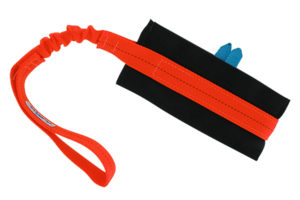Weave Poles
If your goal is to be successful in agility competition, it’s almost imperative to have the ability to train at home. Training once a week at the training center is definitely not enough for your dog to become proficient in weaves, for example – at least not within a reasonable length of time (reasonable for most people, that is).
I believe that all serious agility addicts need the following equipment, at a minimum:
Absolute:
- Set of 12 weave poles
- 6 bar jumps
Very nice to have:
- more bar jumps
- 15-foot tunnel
- one contact obstacle, probably the teeter
and then anything goes after that.
So your investment doesn’t have to be huge, and if you stick with the “absolute” and “very nice” categories you won’t have to move a lot of heavy stuff every week to mow.
You’ll also be able to take your equipment “on the road” with you if it consists only of jumps and weaves. It’s nice to be able to drive to a local park or school and practice in a new and different place, so your dog can learn to generalize playing agility to different locations.
How to acquire equipment
Your options, of course, are to (1) make your own or (2) buy it somewhere — oh, and (3) ask Santa. Some obstacles (especially jumps) are pretty simple to make, and kind of fun. On the other end of the spectrum, you probably cannot make your own tunnel, and the contact equipment can be pretty involved. The best of it is made with welded aluminum and synthetic planks (light-weight, durable, low maintenance). You certainly can make backyard equipment using painted planks on sawhorses; just take extreme care to make it solid enough to hold your dog when he’s running on it, and using treated lumber will save you much heartache and maintenance.
Weave poles
Cheap and easy approaches:
- “Step-on” plastic fence posts from some co-ops and Tractor Supply Company, possibly Home Depot. These have a 4-6″-long spike at the bottom that can be stuck into the ground. The plastic post works nicely as a weave pole (keeping the extrusions pointed outward, of course).
- 18″ Rebar stuck into the ground about 6″ with PVC pipe slipped over top of it.
The above two types of “stick-in-the-ground” weave poles can be used as straight-up poles, angled like “Weave-A-Matics” (WAMs) or placed in a channel fashion:
Channel weaves

(dog runs between them and you can gradually narrow the channel between the rows of poles)
The spacing between weave poles is ideally 22-24″ (with most organizations using 24″ spacing). You can use a piece of wood trim or molding with lines marked every 24″ to help keep the poles straight and properly spaced. For this guide, 8′ should be long enough; you just keep sliding it along as you insert the poles into the ground.
The disadvantage of this type of poles is the inability to use them at some times of the year (ground frozen in winter, concrete-hard in summer). Also, with hard-driving dogs you have to reset them frequently. But they are cheap and do work nicely when the ground cooperates.
You can purchase weave poles from various sources
MAD Agility Equipment http://www.madagility.com/
In Pennsylvania but they frequently provide equipment for local trials, so you can order up front and pick up at a trial (saves on shipping!). They often sell the equipment they used at the trial at the end of a trial at a discount. They sell straight-up poles, channel weaves, and 2 x 2 weaves (another article coming on this).
Stick-in-the-ground weaves from Affordable Agility
Affordable Agility sells online: PVC weave sets that work great for small dogs or dogs that don’t push the poles too hard. They also carry straight-up poles with metal bases AND PVC stick-in-the-ground poles (left). These work fine for teaching by the 2 x 2 method. You can also purchase a “tape” with holes/grommets at 24″ intervals to show where to place your stick-in-the-ground poles. I believe they also have adjustable channel weaves (all PVC).



